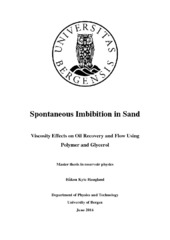Spontaneous Imbibition in Sand - Viscosity Effects on Oil Recovery and Flow Using Polymer and Glycerol
Abstract
Spontaneous imbibition experiments have historically been performed using all faces open (AFO) boundary condition. Due to complex flow patterns consisting of both counter- and co-current flow, modelling flow using established differential equations has been difficult. Recently, however, an alternative boundary condition termed two ends open free spontaneous imbibition (TEOFSI) was studied in detail, and supporting theory was established. In this thesis, co-current spontaneous imbibition was performed using the TEOFSI boundary condition, with one end in contact with wetting phase and the other end in contact with non-wetting phase. Columns of unconsolidated sand were packed in glass imbibition tubes and completely saturated with non-wetting phase. Brine, polymer and glycerol were used as the wetting phase, whereas air and mineral oils with varying viscosity were used as the non-wetting phase. During experiments, front position was recorded and non-wetting phase production was measured separately at each end of the imbibition tube. The viscosity of the non-wetting phase (μnw) was varied over 4 orders of magnitude to study its effect on oil recovery and front behaviour. Recovery decreased from 98% of the pore volume at μnw/μw = 0.016 to 77% of the pore volume at μnw/μw = 63.7. Brine displaced the oil in a piston-like manner for all 4 experiments, except initially for higher viscosity ratios when a sharp front developed some distance from the inlet due to early fingering of the wetting phase and entrapment of the non-wetting phase. Measurements of the front position were matched with theoretical calculations using a method based on the assumption of piston-like displacement during co-current imbibition by Haugen et al. (2014). Due to successfully matching the experimental data, capillary pressure at the front and relative permeability to brine behind the front was calculated. The estimated relative permeability decreased, whereas the capillary pressure increased, with increasing viscosity of the non-wetting phase. The viscosity of the wetting phase (μw) was varied using HPAM polymer and glycerol to study low viscosity ratios in the range of 0.033 to 0.034. Spontaneous imbibition results show that glycerol yielded a 5% higher recovery compared with polymer, using matching aqueous phase viscosity. The lower recovery for polymer may have been caused by polymer retention or wettability alteration. Further studies are required to quantify and understand the mechanisms behind the experimentally observed differences, but it is likely to be influenced by polymer retention during spontaneous imbibition with polymer as the wetting phase.
